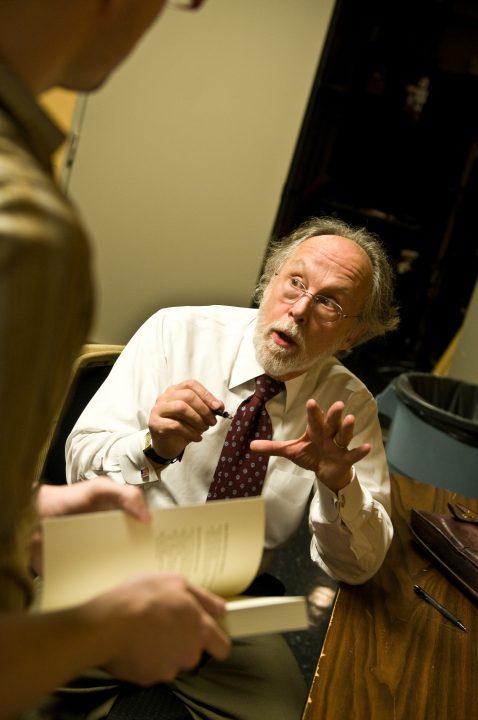To read Barry Lopez is to commune with a deep thinker.
His writings have frequently been compared to those of Henry David Thoreau, as he brings a depth of erudition to the text by immersing himself in his surroundings, deftly integrating his environmental and humanitarian concerns. In his nonfiction, he often examines the relationship between human culture and physical landscape. In his fiction, he frequently addresses issues of intimacy, ethics, and identity.
Barry Lopez is best known as the author of Arctic Dreams, for which he received the National Book Award. Among his other nonfiction books are About This Life, and Of Wolves and Men, which was a National Book Award finalist. He is also the author of several award-winning works of fiction, including Field Notes, Winter Count, and a novella-length fable, Crow and Weasel. His recent work includes Light Action in the Caribbean, a collection of stories, and Resistance (2004), a book of interrelated stories—Lopez’s eloquent response to the recent ideological changes in American society. He is also the co-editor with Debra Gwartney of Home Ground: Language for an American Landscape, a landmark work of language, geography, and folklore. His books, along with his magazine work, reflect a life of travel and cultural inquiry that has taken him to nearly seventy countries.
Once a landscape photographer, Barry Lopez continues to maintain close contact with a diverse community of artists. He is on the advisory board of Theater Grottesco in Santa Fe. He has collaborated with composer John Luther Adams on several concert and theater productions and spoken at openings for sculptor Michael Singer and photographer Robert Adams. In another arena of work, he recently collaborated with E. O. Wilson in the design of a university curriculum that combines the sciences and humanities in a new undergraduate major.
Barry Lopez has received numerous awards and prizes, among them the Literature Award from the American Academy of Arts and Letters, the John Burroughs Medal, a Guggenheim Foundation Fellowship, five National Science Foundation Fellowships, and a Lannan Foundation Fellowship, and the John Hay Medal, as well as Pushcart Prizes in fiction and nonfiction. He is a regular contributor to Granta, The Paris Review, Orion, Manoa, Outside, The Georgia Review, National Geographic, and other periodicals. He lives in rural Western Oregon.
Excerpt from the introduction to Home Ground: Language for an American Landscape (2006)
It had come to me as a fourteen-year-old reading Moby-Dick, a moral drama set in an intensely physical place, that this seemingly unfettered, nearly unmeasurable American landscape I had become acquainted with (Colorado’s fourteeners, Appalachia’s Carolina bays, Manhattan’s tidal races, a complex landscape, robust with suggestions of freedom, powers, and purity) it came to me that this particular landscape had distinctively stamped the long line of American literature, starting with Cooper and Hawthorne and coming up through Twain, Cather, and Steinbeck, through Stegner, Mary Oliver, and Peter Matthiessen, through Wendell Berry and Gary Snyder. In fact, it is striking the degree to which the work of so many American writers is informed by sentences of wonder, meditation, and confoundment, of intimacy, alienation, and homage, inspired by the feature—plowed land, deep woods, mountain stream—of American landscapes. In Inheritance of Night, William Styron writes: “You look out once more at the late summer landscape and the low sorrowful beauty of the tideland stream, turgid and involute and secret and winding through marshes full of small, darting, frightened noises and glistening and dead silent at noon except for a whistle, far off, and a distant rumble on the rails.”
Whatever their styles and emphases, many American poets and novelists have recognized that something emotive abides in the land, and that it can be recognized and evoked even if it cannot be thoroughly plumbed. It is inaccessible to the analytic researcher, invisible to the ironist. To hear the unembodied call of a place, that numinous voice, one has to wait for it to speak through the harmony of its features—the soughing of the wind across it, its upward reach against a clear night sky, its fragrance after a rain. One must wait for the moment when the thing—the hill, the tarn, the lunette, the kiss tank, the caliche flat, the bajada—ceases to be a thing and becomes something that knows we are there.
Selected Work:
Fiction
“Hidian,” TriQuarterly #133, Spring 2009
Field Notes (1994)
Crow and Weasel (1990)
Nonfiction
“An Intimate Geography,” The American Scholar, Fall 2009
“On the Border,” The Georgia Review, Fall 2009
Home Ground: Language for an American Landscape (co-edited with Debra Gwartney, 2006)
Arctic Dreams (2001)
Crossing Open Ground (1989)
Of Wolves and Men (1979)
Links
Barry Lopez’s homepage
January Magazine: Interview by Linda Richards
CBS Radio audio interview, by Don Swaim
